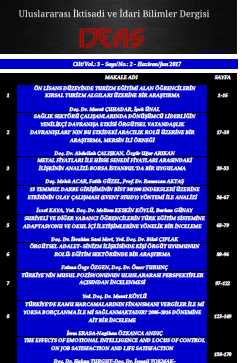ÖRGÜTSEL DIŞLANMA: BİR ÖLÇEK UYARLAMA ÇALIŞMASI
Bu çalışmanın amacı, Ferris vd. (2008) tarafından geliştirilen Örgütsel Dışlanma Ölçeği’nin, Türkçe’ye geçerlilik ve güvenilirliğinin yapılmasıdır. Çalışma örneklemi iki farklı gruptan oluşmaktadır (n=669, n=427). Yapılan analizler neticesinde, orijinal ölçek ile uyumlu bir şekilde tek faktörlü bir yapı elde edilmiştir. Ölçek güvenirlikleri sonucunda ise Cronbach Alpha katsayısı, birinci örneklem grubu için ,942; ikinci örneklem grubu için ,937 olarak bulgulanmıştır. Çalışma sonucunda, ölçeğin, örgütsel dışlanma algısının ölçülmesinde geçerli ve güvenilir bir ölçek olduğu ve Türk toplumunda farklı sektörler için uygulanabilir olduğu tespit edilmiştir.
Anahtar Kelimeler:
Örgütsel Dışlanma Ölçeği, Geçerlilik, Güvenilirlik
ORGANIZATIONAL OSTRACISM: A STUDY OF SCALE ADAPTATION
The purpose of this study is the validity and reliability of the Organizational Ostracism Scale developed by Ferris et al. (2008) in Turkish adaptation. The study sample consists of two different groups (n = 669, n = 427). As a result of the analyzes, it was found that the scale had a single factor structure in accordance with the original factor structure. As a result of the reliability of the scale, Cronbach Alpha coefficient for the whole scale was ,942 for the first sample group and ,937 for the second sample group. The results obtained showed that the scale can be used as a valid and reliable scale to measure the perception of organizational ostracism in different sectors in Turkey.
Keywords:
Organizational Ostracism Scale, Validity, Reliability,
___
- Brislin, R. W., Lonnerwalter J., & Thorndike R. M. (1973). Cross-cultural research methods, New York, John Wiley-SonsPub.
- Büyüköztürk, Ş. (2007). sosyal bilimler için veri analizi el kitabı (7. Baskı). Ankara: Pegem Akademi Yayınları.
- Chung, Y. W. (2015). The mediating effects of organizational conflict on the relationships between workplace ostracism with in-role behavior and organizational citizenship behavior. International Journal of Conflict Management, 26(4), 366-385.
- Çalışkan A., Turunç Ö. ve Akkoç İ. (2014). How does organisational culture affect the innovative behaviours? The mediating role of perceived insider status. International Journal of Innovation and Learning, 16(2), 151-172., doi: 10.1504/IJIL.2014.064364
- Ferris, D. L., Brown, D. J., Berry, J., & Lian, H. (2008). The development and validation of the Workplace Ostracism Scale. Journal of Applied Psychology, 93, 1348–1366.
- Fiset, J., Al Hajj, R., & Vongas, J. G. (2017). Workplace ostracism seen through the lens of power. Frontiers in Psychology, 8(1528), 1-19.
- Fox, S., & Stallworth, L. E. (2005). Racial/ethnic bullying: Exploring links between bullying and racism in the US workplace. Journal of Vocational Behavior, 66, 438–456.
- Gorsalkorale, K., & Williams, K. D. (2007). The KKK won’t let me play: Ostracism even by a despised outgroup hurts. European Journal of Social Psychology, 37, 1176-1186.
- Hair, J. F. J., Black, W. C., Babin, B. J., ve Anderson, R. E. (2010). multivariate data analysis. Seventh Edition, Prentice Hall.
- Halis, M. ve Demirel, Y. (2016). Sosyal desteğin örgütsel soyutlama (dışlanma) üzerine etkisi. Kastamonu Üniversitesi İktisadi ve İdari Bilimler Fakültesi Dergisi, 11, 318-335.
- Hawkley, L. C., Williams, K. D., & Cacioppo, J. T. (2011). Responses to ostracism across childhood. Social, Cognitive and Affective Neuroscience, 6, 234-243.
- Hitlan, R. T. ve Noel, J. (2009). The influence of workplace exclusion and personality on counterproductive work behaviours: An interactionist perspective. European Journal of Work and Organizational Psychology, 18(4), 477-502.
- Kalaycı, Ş. (2006). SPSS uygulamalı çok değişkenli istatistik teknikleri, Asil Yayın Dağıtım.
- Leung, A. S. M., Wu, L. Z., Chen, Y. Y. & Young, M. N. (2011). The impact of workplace ostracism in service organizations. International Journal of Hospitality Management, 30(4), 836-844.
- Meyers, L.S., Gamst, G. C. & Guarino, C. (2005). Applied multivariate research: Design and interpretation, SAGE Publications. ISBN-13: 978-1412904124.
- Mlika, M., Khelil, M. B., & Salem, N. H. (2017). Organizational Ostracism: A potential framework in order to deal with it. Safety and Health at Work, 8, 398- 401.
- Nunnaly, J. C. (1978). Psychometric theory. New York: McGraw-Hill.
- Ocak, M. (2020). Amos İle Adım Adım Yapısal Eşitlik Uygulamaları, Ekin Yayınevi, Bursa.
- Prinstein, M. J., & Aikins, J. W. (2004). Cognitive moderators of the longitudinal association between peer rejection and adolescent depressive symptoms. Journal of Abnormal Child Psychology, 32(2), 147-158.
- Ramsey, A. T. & Jones, E. E. (2016). Minding the Interpersonal Gap: Mindfulness-based Interventions in the Prevention of Ostracism. National Institues Healty Public Access, 31, 24-34.
- Robinson, S. L., O’Reilly, J. & Wang, W. (2013). Invisible At Work An Integrated Model Of Workplace Ostracism. Journal of Management, 39(1), 203-231.
- Sekaran, U. (1992). Research methods for business. Canada: John Wiley ve Sons, Inc.
- Twenge, J. M., Catanese, K. R., & Baumeister, R. F. (2002). Social exclusion causes self-defeating behavior. Journal of Personality and Social Psychology, 83, 606-615.
- Williams, K. D. (2007). Ostracism. Annual Review of Psychology, 58, 425–452.
- Williams, K. D., Cheung, C.K.T., ve Choi, W. (2000). Cyber ostracism: Effects of being ignored over the internet. Journal of Personality and Social Psychology, 79(5), 748-762.
- Yang, J. (2012). Workplace Ostracism And Performance Related Outcomes: A Process Model İncorporating Social İnfluence And Social İdentity Theories. Unpublishen Doktoral‟s Thesis, State Universtiy of New York, USA.
- Zhao, H., Peng, Z., & Sheard, G.(2013). Workplace ostracism and hospitality employees’ counterproductive work behaviors: The joint moderating effects of proactive personality and political skill. International Journal of Hospitality Management, 33, 219-227.
- ISSN: 2149-5823
- Başlangıç: 2015
- Yayıncı: Ömer TURUNÇ
Sayıdaki Diğer Makaleler
ÖRGÜTSEL DIŞLANMA: BİR ÖLÇEK UYARLAMA ÇALIŞMASI
Abdullah ÇALIŞKAN, Nazmiye Ülkü PEKKAN
LİDERLİK TİPLERİNİN ÖRGÜTLERİN KRİZ ALGILAMA VE KRİZLE BAŞA ÇIKMA STRATEJİLERİ ÜZERİNE ETKİSİ
ENFLASYON VE DÖVİZ KURLARI ARASINDAKİ İLİŞKİ: TÜRKİYE ÖRNEĞİ (2005.1 – 2018.12)
SAVUNMA SEKTÖRÜNDE DEĞER ZİNCİRİ ANALİZİ ALGISI VE DEĞERLENDİRİLMESİ
ERZURUM İLİNDE HANEHALKLARININ EV DIŞI GIDA TÜKETİMİNİ ETKİLEYEN FAKTÖRLER
